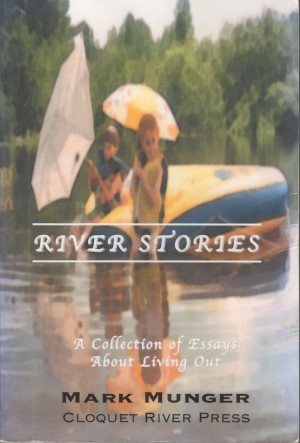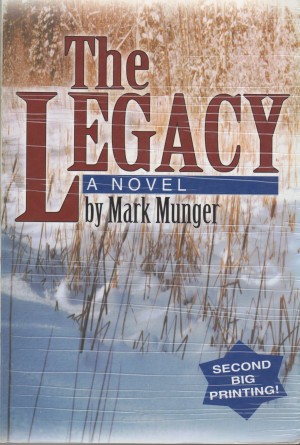I came across the following blurb in the Proctor Journal this past week and it got me to thinking:
10 Years Ago (2002)
Judge Mark Munger will sign his books Ordinary Lives, River Stories, and The Legacy at Northern Lights Books and Gifts…
That passage brought me back to where this all began. My first novel, The Legacy, was published in October of 2000 by a local publisher other than Cloquet River Press (CRP) and had a print run of 1,000 copies. That run was sold out before Thanksgiving, leaving the book’s original publisher and me (the newly-discovered author with the puffed out chest) with no books to sell over the holidays. I suggested a second run. The publisher agreed on one condition: 2,000 additional copies of the book would be printed but, if at the end of the year, any inventory remained unsold, I would buy the books back from the publisher. The deal sounded good to me but then, as a first-time author having just sold out the first run of my debut novel, anything that kept my name in the public eye sounded good. Over the next year (2001) we sold another 1,200 copies. Not bad for a regional writer and his first novel. But as the year drew to a close, the publisher still had 800 copies of The Legacy in inventory: 800 copies that I was responsible to purchase at cost. With my wife’s permission, I borrowed money from our son Chris’s college account (the money was paid back, honest) and fulfilled my half of the bargain. But what to do? I was now the proud owner of boxes of fiction stored in my basement that I had no idea how to sell.
That’s how CRP got its start: as a vehicle to sell copies of The Legacy. I managed to figure out how to obtain a business name from the Minnesota Secretary of State, make contact with distributors get my novel into bookstores, open a business bank account at Wells Fargo, and eventually, with my eldest son Matt’s help, set up this blog site.
But what to do about the two collections I had sitting in the hard drive of my computer? How was I supposed to get my other stories formatted and printed into books if I didn’t know squat about the craft of creating a book?
Early in 2002, I stumbled upon a company called InstantPublisher.com (IP), an online printing service that started as a firm dedicated to printing church cookbooks and, with the advent of digital laser printing technology, entered into the world of book publishing. I figured out how to submit my drafts to IP and my wife Rene’ figured out how to create cover art that fit IP’s templates. We then went to work creating books.
The first two CRP titles, Ordinary Lives, a collection of short fiction I’d been writing for a decade, and River Stories, a collection of essays I’d written for the Hermantown Star, were the beginning of my adventure in the world of self-publishing.
 Both books were printed in very limited (25 copies per title) runs so that I could ensure myself that the quality of IP’s process was at least equal to the traditional offset printing process that had created The Legacy. When the books arrived at our house on the banks of the Cloquet River on a windy, rainy day in May 2002, I was nearly as excited as when I’d first held a completed copy of The Legacy. For those of you who’ve not poured your heart out on the page and waited patiently for the words you’ve written to return in the form of a finished book, well, the only experience I can equate holding a brand new title in your hands with is that of holding a child, your child, for the very first time. Don’t get me wrong: It’s not quite the same. But it’s close.
Both books were printed in very limited (25 copies per title) runs so that I could ensure myself that the quality of IP’s process was at least equal to the traditional offset printing process that had created The Legacy. When the books arrived at our house on the banks of the Cloquet River on a windy, rainy day in May 2002, I was nearly as excited as when I’d first held a completed copy of The Legacy. For those of you who’ve not poured your heart out on the page and waited patiently for the words you’ve written to return in the form of a finished book, well, the only experience I can equate holding a brand new title in your hands with is that of holding a child, your child, for the very first time. Don’t get me wrong: It’s not quite the same. But it’s close.
Though I’d ventured into the world of self-publication in 2002, I still tried mightily to locate a literary agent who could connect me to a mainstream publisher: a big New York operation that would pay me a fat advance and publish my work. Despite dedication to task, it didn’t work out that way. I have enough rejection letters to paper the room I write in with several hundred left over for alternative use in the commode! My big break never came so I plowed ahead with CRP, churning out books like nobody’s business, oblivious to the mountain of red ink I was creating.
For you see, the vanity book business isn’t generally susceptible to get-rich-quick schemes of its authors: Even those of us who (and I say this with as much modesty as I can muster) achieve a small measure of artistic success and a loyal following don’t usually see a return on our financial investment. Never mind being paid for the time we spend writing, editing, and creating our books, labor which will never, ever be compensated. No, for us, the little guys and gals dreaming big dreams of fame, fortune, and success at the end of the self-publishing rainbow, reality is being satisfied that your work is being read, not financial stability.
Oh sure, I know. John Grisham started as a vanity author. He had thousands of copies of A Time to Kill sitting unsold in his basement when he optioned his second book, The Firm, to a New York publisher through a literary agent (the traditional path to writerly success). Dickens. Clemens. Woolf. These are all folks who walked the self-publishing path at one point or another in their careers. So it is possible for someone like me, someone whose words flow into the world of ideas by means of my own sweat, to make it, to become financially viable. But for every Grisham, I’m afraid, there are a thousand Mungers. That’s just the reality of today’s literary marketplace.
After my two collections tested the water, I found there was a modest demand for my writing without an established publisher. So I kept at it. And at it. And at it. In early 2003, my second novel, Pigs, A Trial Lawyer’s Story, came out. My best selling work to date (Suomalaiset: People of the Marsh) was released by CRP in 2004 and led my wife and I to Finland in promotion of that historical novel. A second collection of essays from my days as a newspaper writer (Doc the Bunny and Other Short Tales) followed. My first foray into contemporary, book club-style women’s fiction, Esther’s Race, was published in 2007. Mr. Environment: The Willard Munger Story, my first (and I promise, my only) stab at biography hit bookstores in 2009. And this past March, a sequel (of sorts) to The Legacy (Laman’s River) came out both as a trade paperback and, for the very first time, as an eBook.
9 books in 12 years. Some might wonder whether I’ve spent enough time crafting each story, each manuscript, cramming so many words into so many books in such a short time frame. But here’s the thing: I began writing seriously in 1990. While I worked on and marketed The Legacy to agents, I also wrote the short fiction that became Ordinary Lives, submitted essays to the Hermantown Star for eight years (stories that were compiled later in River Stories and Doc the Bunny), and hammered away at the lengthy and autobiographical Pigs, so that, by 2002 when CRP was formed, I had a body of work in reserve, ready to be transformed into books. After that, other than the biography (which was a five year endeavor of love in memory of my late uncle) each novel has taken, on average, 1 and 1/2 to 3 years to create and release.
To be sure: Not every story or essay or chapter or scene I’ve written over the past twenty-two years has been great, or, in some cases, even good. And I’ve learned to rely upon friends, experts, and relatives to function as first readers; to self-edit my work using their criticisms; and then hire a professional editor to put the finishing touches on my sentences and paragraphs. Still, there are errors. Still, my books venture out into the universe in less than perfect form. And still, the red ink flows. But here I am, on the cusp of sixty years old, nine books to my credit and a tenth being vetted by my trusted first readers as I write this piece. Why do I insist? Why, after a decade of butting my head against the concrete wall of the world’s greater indifference, do I continue on, do I allow CRP to continue its existence? The answer is very simple: I have stories to tell and folks seem to enjoy them. It’s as simple as that.
So, in this tenth year of Cloquet River Press’s existence, despite the red ink, despite the frustrations of being undiscovered (or barely discovered), me and my little press will continue on so long as there are folks out there who want to read my words. If you like what I write, it wouldn’t hurt to tell other folks about CRP, its books, and this blog.
One never knows.
Peace.




